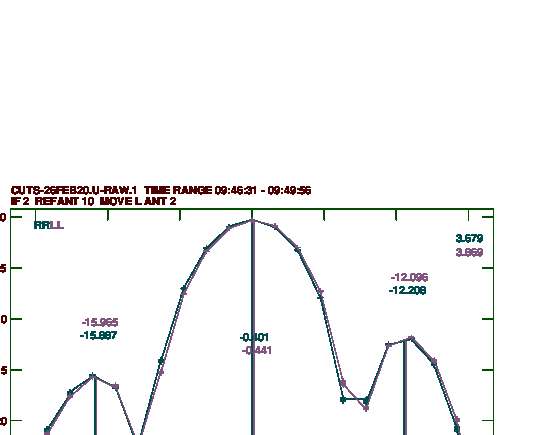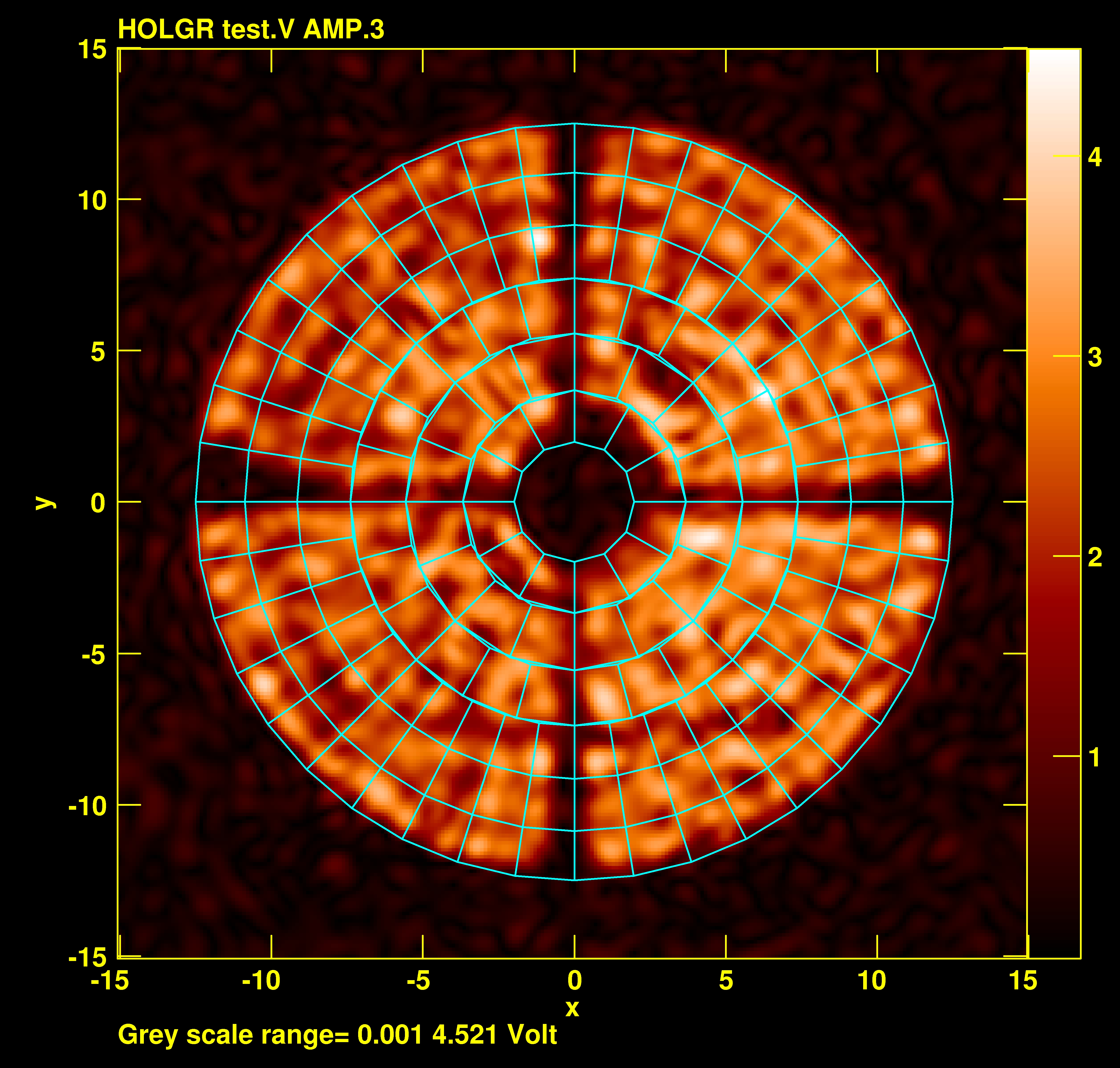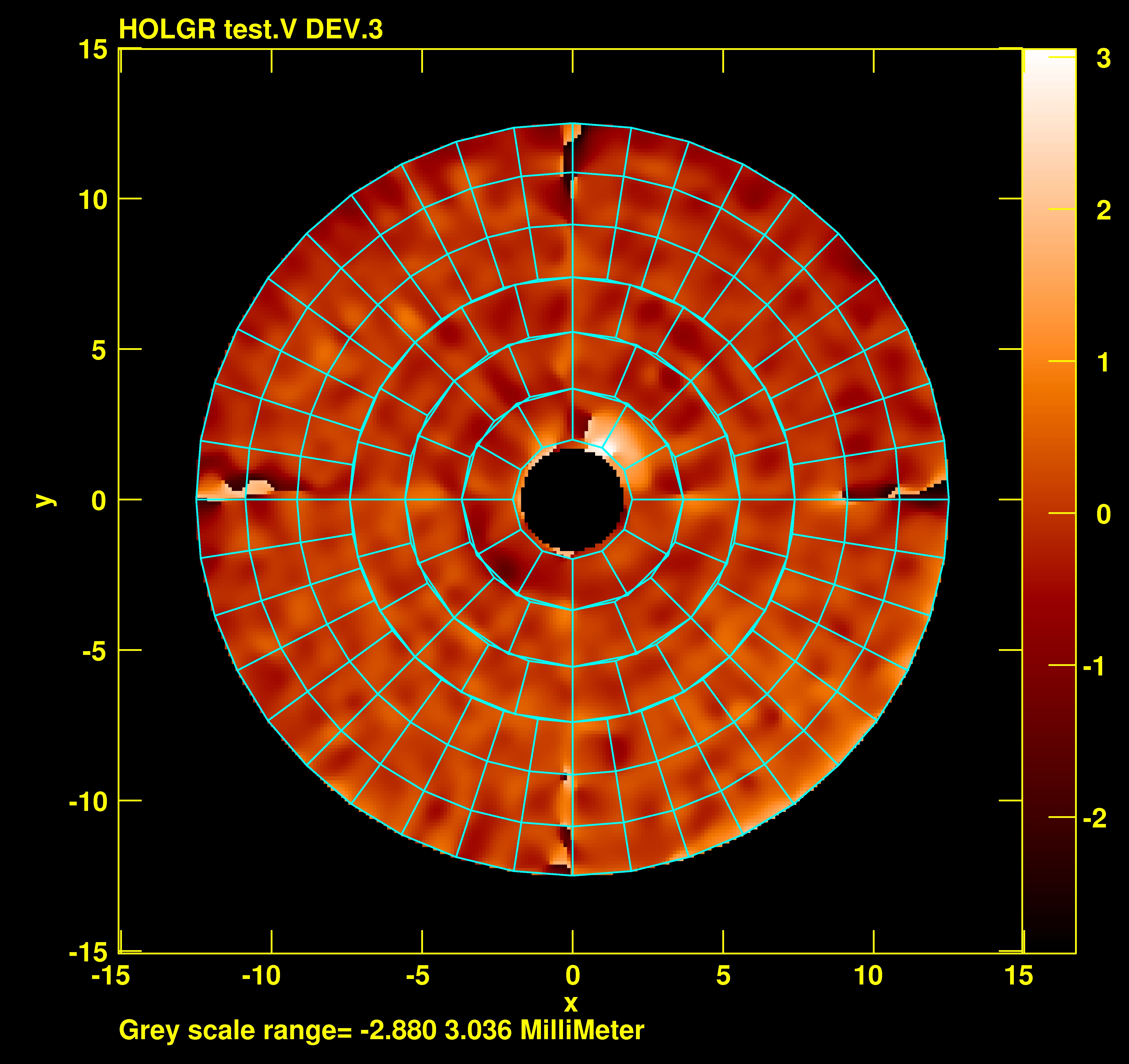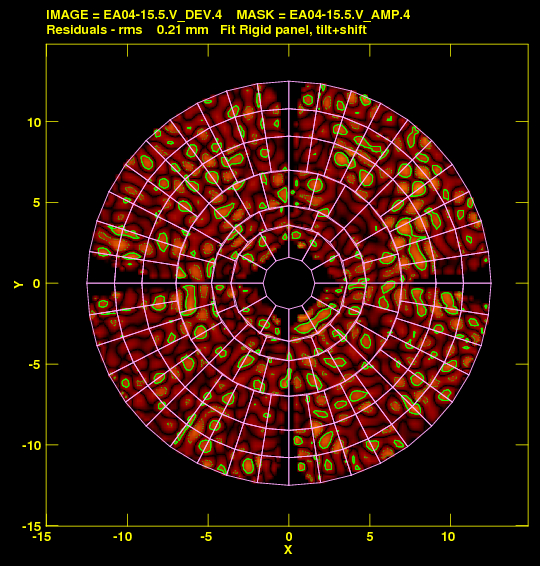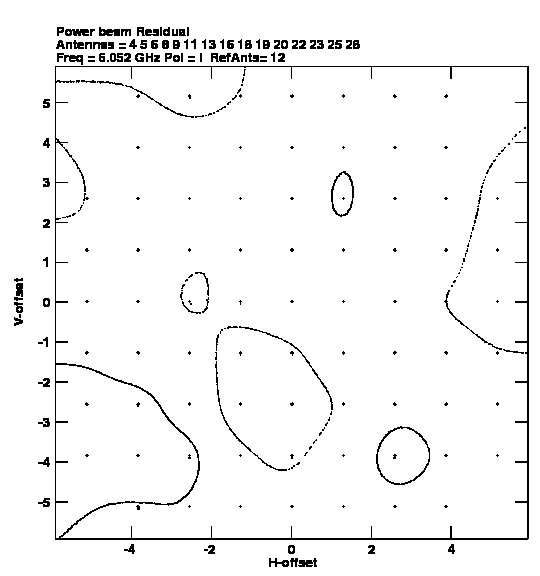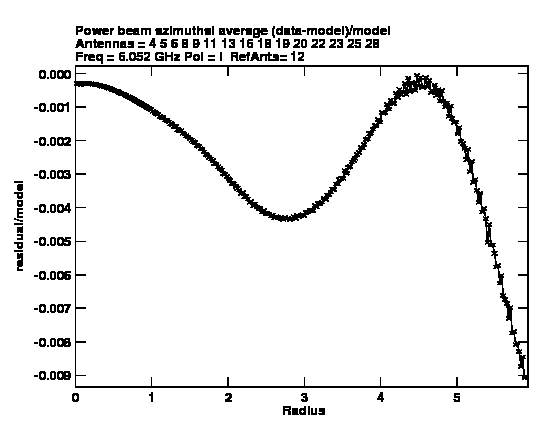V.4 Improving antenna surfaces: holography
In “holography” data from the EVLA, reference antennas are pointed towards the nominal source position, as
normal. All other antennas are pointed to an offset position controlled by the observer. The angular offset from the
nominal position, for each antenna, is written to data sets in the same variables that are normally used for u,v,w.
Normally, when UVCOP is used to select IFs, the values of u,v,w are scaled to the new header frequency. To prevent
this, set UVCOPPRM(8) = 1 and, if any holography sources have names other than HOLORASTER, also set
SRCALIAS.
In holography mode, only data on a baseline between a reference antenna and an offset (non-reference) antenna are
normally used. (Data between two moving antennas may be plotted by UVHOL however.) The correlations observed
on these baselines are stored in the multi-source file in the normal way. Data are calibrated as usual and then
extracted with UVHOL for holographic analysis. This analysis includes determination of the shapes of the primary
beams with PBEAM, Fourier analysis with HOLOG to make images of the dish surface including the deviations from
the desired shape, and finally PANEL to prepare detailed prescriptions for adjusting the antenna panels. Verb
TVLAYOUT plots an antenna panel layout on top of a TV holography image and has the layouts for the VLA and
VLBA built in.
Holography data are taken by driving the moving antennas to a desired offset and then dwelling for a period of
time, accumulating some number of samples. Then the moving antennas are driven to the next desired offset,
usually horizontally or vertically, and the process is repeated. Holography samples are recorded with the u random
parameter as the azimuth offset direction cosine, the v random parameter as the elevation direction
cosine, and the w random parameter as a counter of the dwell interval. In the old VLA, the w had
an additional 40000.0 added as a holography indicator. With the EVLA, the source name is the sole
method of discriminating between regular visibility data taken for calibration and the holography
data.
Beginning in late 2022 and supported only in 31DEC23 (and beyond), a new “on the fly” mode of holography
observation has been introduced. In that mode, the moving antennas move continuously at the user-specified rate.
This is much faster since there is not need to blank data while the telescopes start up and then settle at the new
position. Of course, the data integration time at each offset position is considerably reduced. UVHOL and HOLOG have
the new adverb OTFMODE to tell the tasks that the data were taken in this mode and to tell HOLOG to average the data
in time if necessary. In this mode, the w parameter does not appear to have any reliable meaning,
and UVHOL treats each new time as a new position. Otherwise, these tasks function as they always
have.
In 31DEC23, the task HOLIS lists the groups of holography data showing which scans contain which range of
coordinates. It tests for data samples out of order in OTF mode calling them “Backwards.” It calls each scan at
constant L or M a group in OTF mode and each dwell position a group in non-OTF mode. It can print a very
detailed account of the latter or a summary. This listing should allow the user to find particular coordinates for
plotting in UVHOL.
UVHOL has three main modes of operation: printing the data much like UVPRT, averaging and writing the data to text
files for analysis by HOLOG, and plotting the data in 


 plot files or on the TV display. UVHOL has all of the usual
data selection and calibration adverbs. In addition it has a number of basic holography-specific adverbs. ANTENNAS
is used to list the reference antennas and BASELINE is used to list the moving antennas. Since it takes some time for
the antennas to settle down after each move, adverbs NPOINTS or APARM(1) through APARM(3) control which
samples within each pointing are retained. APARM also controls whether the data are averaged over all moving
antennas and/or all reference antennas and/or over time. Normally, holography data should not have the
parallactic angle correction applied on DOPOL, but it can be done if desired. DPARM is used to advise the print
routines on scaling of data and weights and also to invoke special plotting options (use db for amplitudes, plot
phase or imaginary rather than amplitude/real). There are a number of the usual plot options, such as
SYMBOL, DO3COL, LTYPE, and the like. DPARM(8)=1 has the task fit the main and sidelobe peaks and
display the values on the plot. DOCRT controls where the print out is sent, either to the terminal or to
OUTPRINT.
plot files or on the TV display. UVHOL has all of the usual
data selection and calibration adverbs. In addition it has a number of basic holography-specific adverbs. ANTENNAS
is used to list the reference antennas and BASELINE is used to list the moving antennas. Since it takes some time for
the antennas to settle down after each move, adverbs NPOINTS or APARM(1) through APARM(3) control which
samples within each pointing are retained. APARM also controls whether the data are averaged over all moving
antennas and/or all reference antennas and/or over time. Normally, holography data should not have the
parallactic angle correction applied on DOPOL, but it can be done if desired. DPARM is used to advise the print
routines on scaling of data and weights and also to invoke special plotting options (use db for amplitudes, plot
phase or imaginary rather than amplitude/real). There are a number of the usual plot options, such as
SYMBOL, DO3COL, LTYPE, and the like. DPARM(8)=1 has the task fit the main and sidelobe peaks and
display the values on the plot. DOCRT controls where the print out is sent, either to the terminal or to
OUTPRINT.
On OPTYPE=’HOLG’ mode, the holography data are written to text files, a number of files for each
pair of antennas. Each line of these files, after a number of header lines, contains l, m, amplitude or
real, phase or imaginary, error in amplitude or real, and error in phase or imaginary. In this mode,
OUTPRINT specifies the logical directory name of the output files which are then named with an additional
HOLOnn-mmppii where nn is the reference antenna (BASELINE(j) or 0 if multiple), mm is the antenna
(or 0 if multiple), pp are 2 letters giving the polarization, and ii is the IF. These files are then given to
HOLOG.
An example of plotting one short raster at 4.8 GHz has inputs
> DEFAULT UVHOL C R | to initialize the task name and all adverbs. |
> INDISK n ; GETN m C R | to specify the holography data set. |
> SOURCES ’HOLORASTER’ ’ C R | to specify the standard holography source name. Required
with EVLA data. Note the extra quote mark at the end which
makes all the other values of SOURCES blank. |
> STOKES ’HALF” C R | to plot RR and LL. |
> ANTENNAS 9,0 C R | to specify one reference antenna. |
> BASELINE 8,0 C R | to specify one moving antenna. |
> ICHANSEL 5, 60 C R | to omit outer channels from the average. |
> APARM 1, 3, 2 C R | to include all but the first 3 samples and last 2 in each pointing
with no averaging. |
> DPARM 0 0 0 0 0 1 0 1 C R | to plot amplitudes in db and to find the center and sidelobe
maxima and display and plot their locations, values, and ratio
in db. |
> DO3COLOR 1 C R | to plot the two polarizations in different colors. |
> OPTYPE ’PLOT’ C R | to make plots rather than output text. |
> INP C R | to check the inputs. |
> GO C R | to make the plot file shown in Figure V.2. |
Now, to continue the holography analysis, we write out the data in appropriate text files. An example, would
be
> OUTPRINT ’MYAREA:’ C R | to set the logical directory for the output text files. |
> ANTENNAS 1, 5, 9, 17 C R | to specify more of the reference antennas. |
> APARM 1, 3, 2, 0, 1, 1 C R | to include all but the first 3 samples and last 2 in each pointing
averaging over time within the pointing and over all reference
antennas. |
> INP C R | to double check the inputs. |
> GO C R | to write out the data for HOLOG. |
This will write a file named MYAREA:HOLO00-08RR01 and one named MYAREA:HOLO00-08LL01. Note that we did not
specify the one IF to be used, so IF number one was what we got.
HOLOG reads the visibility data from the text file produced by UVHOL. It can read either amplitude and
phase or real and imaginary (APARM(7) in UVHOL). It then Fourier transforms the data to produce the
grading in the aperture plane of the antenna. Images of the re-gridded observed amplitude and phase
(A_AMP, A_PHA), of the weights in the re-gridding (WGT), of the derived amplitude and phase of the
illumination in the antenna aperture (V_AMP, V_PHA), of the amplitude and phase of the point-spread
function (P_AMP, P_PHA), of the phase corrections removed by the focus model (MODEL), of the surface
deviations of the antenna (V_DEV) in meters, and of the interpolated antenna power pattern (A_PWR)
may be produced under control of adverb DPARM. Task PANEL requires V_AMP (DPARM(4)) for the mask
and V_DEV (DPARM(9) for the deviations. An example of the images produced by HOLOG is shown in
Figure V.3.
Many of the control adverbs must be set to appropriate values. A sample set of inputs is
> INFILE ’MYAREA:HOLO00-28RR01 C R | to point at the text file, 28 is the moving antenna with several
reference antennas. |
> OUTNAME ’28-Q2-40935E’ C R | to name the output images. |
> OPTYPE ’SUBR’ C R | to specify the type of antenna, sub-reflector, sub-reflector with
reference pointing, or primary focus. |
> FACTOR 13 C R | to set magnification factor for sub-reflector antennas; default
13.0. |
> OFFSET 0.512 C R | to set the distance from the prime focus to the bottom of the
subreflector in meters; 0 -¿ 0.512. |
> APARM 0, -1, 25, 3.4, 9 C R | to set antenna outer diameter, inner diameter, and focal length
in meters. |
> BPARM 30, 256, 0, 1, 1, -2, -2.5, -12, 8100, -1 C R | to set data reduction parameters. |
> DPARM 0 0 0 1 0 1 0 1 1 0 C R | to request V_AMP, P_AMP , MODEL, and V_DEV images. |
> INP C R | to double check everything. |
> GO C R | to make the images. |
BPARM specifies the required image size in meters, the image size in pixels, minimum and maximum antenna scan
angle, amplitude scaling factor, Fourier transform control (-2 says use DFT with VLA sign convention), minimum
and maximum coordinate used in correcting for pointing, focus, and feed offset (negative says in the radial
coordinate), a control parameter (100 inhibits local phase ambiguity correction in the V_PHA plane, 8000 turns on
finding the Cassegrain offset), and type of data (-1 for VLA). The image size in meters is a function of frequency. To
avoid this, CELLSIZE may be set to override BPARM(1) when analyzing multiple frequencies. CPARM all zero says to
use the default spheroidal function in gridding on both L and M axes; highly recommended, but not
relevant when using DFT imaging. Note that HOLOG can also generate images from a feed model using
VPARM.
In 31DEC23, an experimental task HOCLN was written to do a Clean operation on the images produced by HOLOG.
Normally, data sampling in holography is essentially on a regular grid at or less than the critical sampling. As a
result, this complex Clean operation usually is of little value.
The last task in the process of measuring corrections to the antenna surface is PANEL
> INDISK n ; GETN m C R | to specify the V_DEV image. |
> IN2DI i ; GET2N j C R | to specify the V_AMP image used as a mask. |
> OUTFILE ’MYAREA:PANEL.out C R | to specify the text file to receive the panel adjustment
instructions. |
> DOPLOT 7 C R | to request plots of the input deviations, the panel adjustments,
and the residuals. |
> APARM 2, 1, 0, 0, 42 C R | To set the panel model, the clip level in the mask image, and
the number of pointings. The map size and frequency should
be available from the image header. |
> INLIST ’ ’ C R | to use the default VLA panel layout. |
> INP C R | to review the inputs. |
> GO C R | to fit the data, write the adjustment instructions, and make
plots. |
The corrections are determined by fitting all samples in each panel to a model of a rigid panel with only shift or
with tilt and shift or a flexible panel. There are a large number of samples in each panel, so in 31DEC23, an option to
omit samples near the edges of panels was added. This APARM(6) option allows the user to suppress effects spilling
over from adjacent panels. Example plots of the panel adjustments and residual are shown in Figure V.4. Adding 8
to DOPLOT produces an image of the dish with all panels marked to show the corner definitions which rotate around
the dish.
With appropriate holography data, the output of UVHOL may also be used to fit an analytic function to the
primary beam. The task that does this is called PBEAM and it fits a polynomial function and makes
contour plots of the input data, the fit model, the residual, and IRING-like plots comparing data and
model in two colors, and then IRING-like plots of the residual image and residual image divided by the
model. Plots against radius of the smooth model with the data points and of the residuals may also be
generated.
Sample inputs could contain
> OUTNAME ’PBEAM Cband C R | to make output images of the data, model, and residual.
Required if DOTV is false and DOPLOT is > 0. |
> INFILE ’MYWORK:C-6052I_1’ C R | to provide the text file from UVHOL. |
> OUTFILE ’MYWORK:CbandTxt C R | to save the messages including answers to a text file. |
> VPARM 0 C R | to use all defaults in the fitting. |
> DOPLOT 15 C R | to get all possible plots. |
> OPTYPE ’ELLI’ C R | to fit eccentricity and position angle. |
> INP C R | to double check everything. |
> GO C R | to do the fit and write out images and plots. |
Sample plots are shown in Figure V.5.



 plot files or on the TV display. UVHOL has all of the usual
data selection and calibration adverbs. In addition it has a number of basic holography-specific adverbs. ANTENNAS
is used to list the reference antennas and BASELINE is used to list the moving antennas. Since it takes some time for
the antennas to settle down after each move, adverbs NPOINTS or APARM(1) through APARM(3) control which
samples within each pointing are retained. APARM also controls whether the data are averaged over all moving
antennas and/or all reference antennas and/or over time. Normally, holography data should not have the
parallactic angle correction applied on DOPOL, but it can be done if desired. DPARM is used to advise the print
routines on scaling of data and weights and also to invoke special plotting options (use db for amplitudes, plot
phase or imaginary rather than amplitude/real). There are a number of the usual plot options, such as
SYMBOL, DO3COL, LTYPE, and the like. DPARM(8)=1 has the task fit the main and sidelobe peaks and
display the values on the plot. DOCRT controls where the print out is sent, either to the terminal or to
OUTPRINT.
plot files or on the TV display. UVHOL has all of the usual
data selection and calibration adverbs. In addition it has a number of basic holography-specific adverbs. ANTENNAS
is used to list the reference antennas and BASELINE is used to list the moving antennas. Since it takes some time for
the antennas to settle down after each move, adverbs NPOINTS or APARM(1) through APARM(3) control which
samples within each pointing are retained. APARM also controls whether the data are averaged over all moving
antennas and/or all reference antennas and/or over time. Normally, holography data should not have the
parallactic angle correction applied on DOPOL, but it can be done if desired. DPARM is used to advise the print
routines on scaling of data and weights and also to invoke special plotting options (use db for amplitudes, plot
phase or imaginary rather than amplitude/real). There are a number of the usual plot options, such as
SYMBOL, DO3COL, LTYPE, and the like. DPARM(8)=1 has the task fit the main and sidelobe peaks and
display the values on the plot. DOCRT controls where the print out is sent, either to the terminal or to
OUTPRINT.
